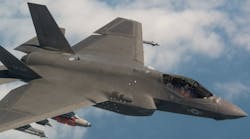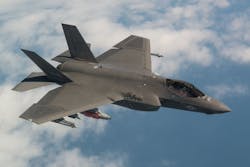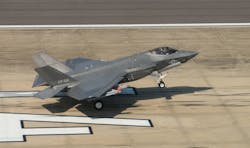F-35 military aircraft completes comprehensive SDD phase flight tests
NAVAL AIR STATION PATUXENT RIVER, Md. The F-35 Lightning II Joint Strike Fightermilitary aircraft program has reached a milestone: the final developmental test flight of the System Development and Demonstration (SDD) phase. On 11 April 2018 at Naval Air Station Patuxent River in Maryland, U.S. Navy test aircraft CF-2 completed a mission to collect loads data while carrying 2,000-pound external GBU-31 Joint Direct Attack Munitions (JDAM) and AIM-9X Sidewinder heat-seeking missiles – marking the final test flight.
“Completing F-35 SDD flight test is the culmination of years of hard work and dedication from the joint government and industry team,” says F-35 Program Executive Officer Vice Adm. Mat Winter.
From flight sciences to mission systems testing, the work completed by F-35 test teams cleared the way for the Block 3F capability to be delivered to the operational warfighter. More than 1,000 SDD flight test engineers, maintainers, pilots, and support personnel took the three variants of the F-35 through the full flight envelope to test aircraft performance and flying capabilities.
The test team conducted six at-sea detachments and performed more than 1,500 vertical landing tests on the F-35B variant, officials say. The developmental flight test team completed 183 Weapon Separation Tests, 46 Weapons Delivery Accuracy tests, and 33 Mission Effectiveness tests, which included multi-ship missions of up to eight F-35s against advanced threats.
“Since the first flight of AA-1 in 2006, the developmental flight test program has operated for more than 11 years mishap-free, conducting more than 9,200 sorties, accumulating over 17,000 flight hours, and executing more than 65,000 test points to verify the design, durability, software, sensors, weapons capability, and performance for all three F-35 variants,” Winter adds.
Developmental flight test is a key component of the F-35 program’s SDD phase, which will formally be completed following an Operational Test and Evaluation and a Department of Defense decision to go into full-rate aircraft production.
“The F-35 flight test program represents the most comprehensive, rigorous, and the safest developmental flight test program in aviation history,” affirms Greg Ulmer, Lockheed Martin’s vice president and general manager of the F-35 program. “The joint government and industry team demonstrated exceptional collaboration and expertise, and the results have given the men and women who fly the F-35 great confidence in its transformational capability.”
SDD-required flight test is now complete, yet F-35 flight testing continues in support of phased capability improvements and modernization of the F-35 air system – part of the Joint Program Office’s Continuous Capability Development and Delivery (C2D2) framework, designed to provide incremental warfighting capability improvements to maintain joint air dominance against evolving threats.
With stealth technology, advanced sensors, weapons capacity and range, the F-35 is a lethal, survivable, connected fighter aircraft offering the ability to collect, analyze, and share data – a force multiplier that enhances airborne, surface, and ground-based assets in the battlespace, officials say.
Headquartered in Bethesda, Maryland, Lockheed Martin is a global security and aerospace company that employs approximately 100,000 people worldwide and is principally engaged in the research, design, development, manufacture, integration, and sustainment of advanced technology systems, products and services.


